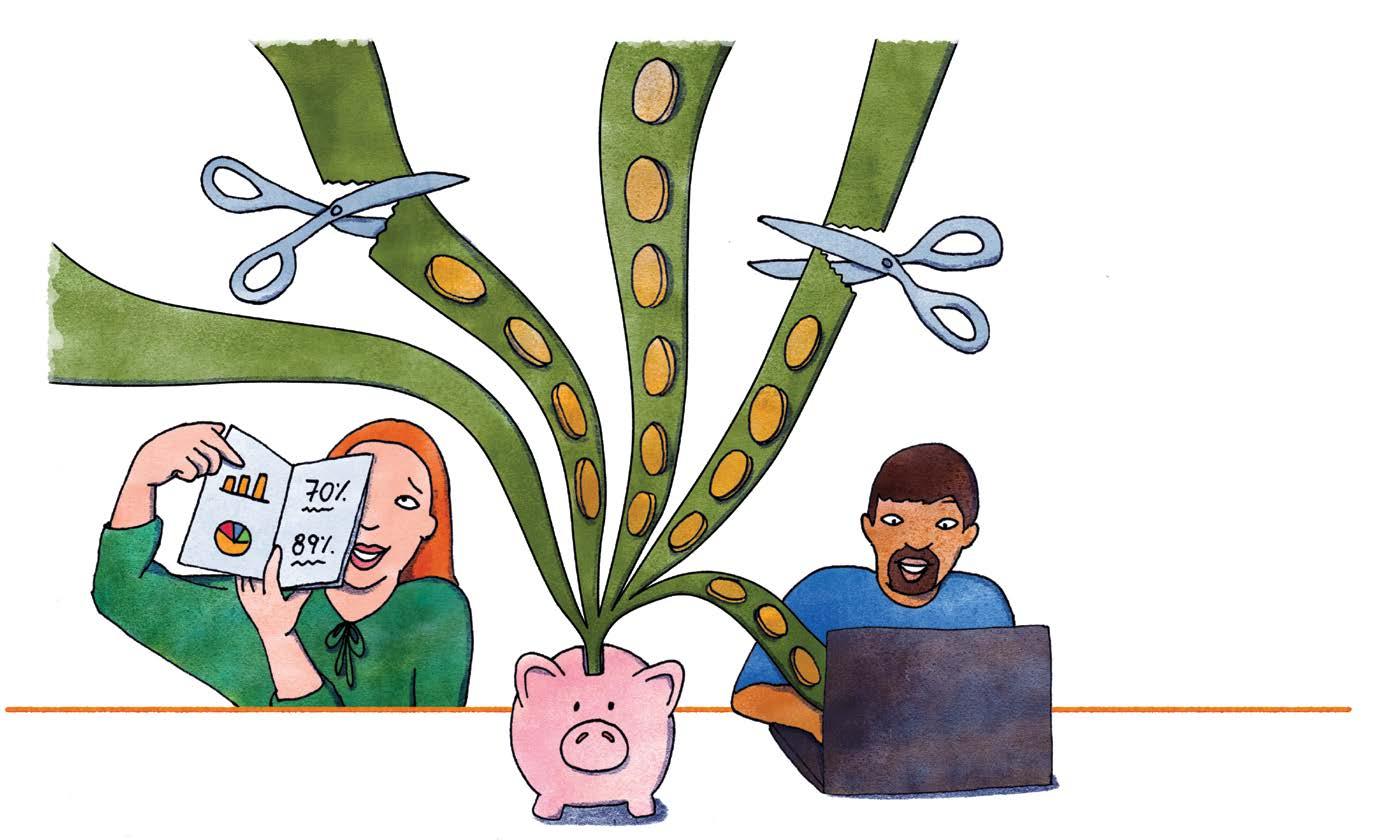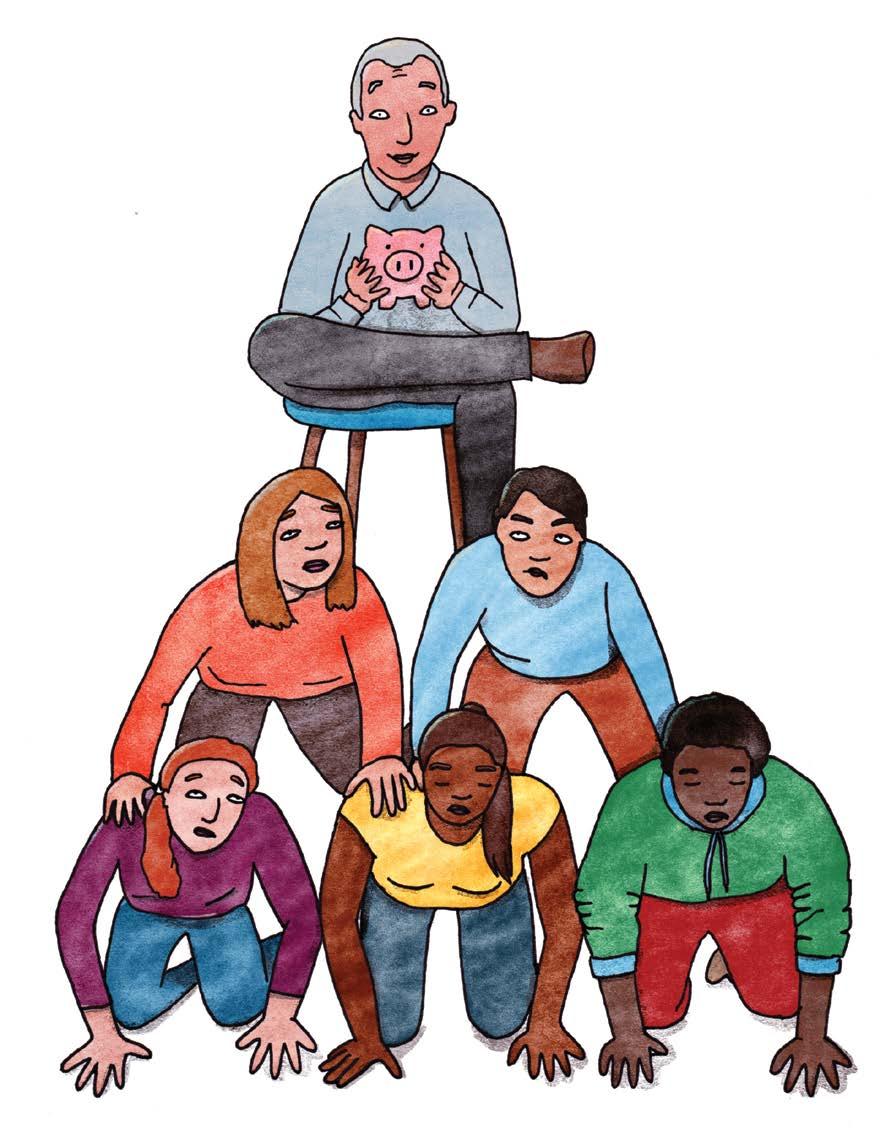
12 minute read
CHAPTER FIVE
How Donors Can Nurture Collaboration
Let me ask it straight. What are some of the more liberating donor approaches that can understand and meet the complexities of collaboration?
Advertisement
A well posed question, Sani. I would like to add that it is not just about donors but about everyone seeing resourcing in a different way.
Peering into the resourcing paradigms of business, government and civil society
Businesses are owned, financed and managed in ways that suit their needs, including their investment approaches, their risk management strategies and core work processes. Their products and services are visible and countable. Measuring the impact of funding or investments, as profit margins, is straightforward. To some extent the same is true for many government agencies and programmes. Infrastructure and basic services like health, education, social security etc., are mostly visible and measurable and the funding and financing of their work processes, serving a fixed and known “market”, may be complicated but is not complex. The donors of civil society, whose leaders and staff often have government or business backgrounds, too often treat civil society organisations as nonprofit businesses or bureaucratic projects. The way they fund the work of CSOs often misses the complexity, the unpredictability and long-term nature of social change work. They love to talk about “measuring impact” as if it were a simple matter of counting. Albert Einstein had this say:
“Not everything that counts can be counted, and not everything that can be counted counts.” It is true that many civil society organisations undertake funded service delivery projects, operating effectively as non-profit businesses rather than agents of social change and perhaps the impact of their work can be more easily gauged. But those who tackle human rights violations, including the social, economic, political and cultural transformation have highly complex practices tackling multifaceted issues, requiring a different paradigm of resourcing that takes account of this. Even within civil society there is a diversity that requires nuanced resourcing, for example between formal and informal organisational forms or between long-term capacity development programmes or shorter-term campaigns. And then the collaborative work of networks, coalitions and platforms adds yet another layer of complexity to the kind of resourcing support needed. But only a few donors understand or are able to provide this.


How do we help donors to see themselves as partners tasked with supporting civil society resilience and resourcefulness in developmental ways, rather than the hard-nosed bankers of the sector? How do we value, make visible, and care for the invisible contributions and resources that allow organisations, networks and platforms to thrive?
Current trends in resourcing civil society
In 2019 Forus published “Funding civil society organisations & networks: Promising approaches to financing Development in the 21st century” (Forus (2019)). The report highlights the following trends: Lack of diversity in funding modalities for networks: for the majority of networks there is a lack of diversity in funding for the work of networks, especially for those in the Global South, resulting in networks depending on a small number of donors and few able to find resources to support their core costs. Shrinking traditional funding streams: traditional funding streams have been shrinking over the last while and this has resulted in uncertainty for civil society networks. This has been accompanied by donor requirements for demonstrating impact becoming more stringent.
Emergence of new funding mechanisms (crowdfunding and online lending
platforms): new mechanisms that move civil society networks beyond traditional funders and connect them to lenders and entrepreneurs. The difficulty that networks have to demonstrate direct impact: the background bridging work of networks is removed from direct contact with people on the ground, and so they often struggle to demonstrate or articulate their impact or contributions.
Unrestricted income sources (impact investments, social enterprise or income
generation): These new mechanisms are beginning to provide opportunities for unrestricted, reliable funding for networks, coalitions and platforms. Shrinking space for civil society: This is affecting the sustainability of many networks diminishing their ability to attract the requisite funding resources and support. Sharing and learning from peers: Although some civil society networks are having success with some resourcing approaches, there is not yet extensive sharing and learning from peers. This is an aspect that needs to be encouraged and supported. Slow in looking ahead and preparing for funding challenges: Although there might be signals from the context, civil society networks and organisations are slow in preparing for upcoming funding challenges. Because of this, they are often negatively impacted by changes in funding climates.
How to restrict the work of civil society and collaboration
Here we will look at various ways in which current resourcing practices restrict, limit and or undermine the complex work of CSOs:
LACK OF UNRESTRICTED, FLEXIBLE FUNDING
The private sector, government agencies and private foundations enjoy the opportunity for long term planning. But, due to restricted funding and lack of reserves, most civil society organisations don’t, leaving them less able to take risks, innovate, and learn. Critically, the lack of a flexible funding limits and hinders meaningful collaboration across various strands of civil society work. Donor funding, despite the donor-speak that promotes collaboration, too often promotes competition and kills trust between CSOs.
FUNDING NETWORKS IN COMPETITION WITH THEIR MEMBERS
In some contexts, it has become common practice for donors to fund civil society networks to take on projects normally undertaken by members, creating conflict and division. The need for resources then pushes these networks to act as intermediary delivery agents of donors and project implementors, taking away from their primary role as facilitators and convenors. This leads to destructive tensions between networks and member organisations and compromises their social change initiatives.
AGENDA-SETTING BY DONOR COUNTRIES
Agendas for aid often serve the national economic or political interests of the donor country, rather than social change and poverty reduction objectives identified locally. This leads to unsustainable initiatives that are often a counterforce to local social change efforts.
DOMINANCE OF PROJECT APPROACHES WITH NO FUNDING SUPPORT FOR LONG-TERM CHANGE PROCESSES
Current resourcing practices are dominated by logical frameworks with simplistic project approaches and tight timeframes and outcomes, which often provide little or no support for long-term change and transformation processes and certainly avoid messy collaborations. Several of the “soft” elements that we spoke about in Chapter 4, such as trust, listening spaces and reflection are invisible in project applications, results frameworks and budgets. Therefore, many of the contributions made by social activists and organisations, especially at local level, go unseen and unrecognised. Most problematic is that donors’ mechanistic, chronological time paradigms of project deadlines disrespect the more fluid and organic time paradigms of the struggles and development of marginalised communities. This often forces the intermediary NGOs into bullying behaviours with local communities that disempower and undermine the goals of the initiatives.


Alternative resourcing approaches and practices
Over the last while there has been a move by some donor agencies, private foundations and civil society coalitions, networks and movements to actively explore and experiment with alternative, innovative resourcing approaches and practices.
ECOSYSTEM APPROACH TO FUNDING
The Association for Women’s Rights in Development (AWID) is a global, feminist, membership, movement support organisation. It supports feminist, women’s rights and gender justice movements to thrive, be a driving force in challenging systems of oppression and to co-create new feminist realities. AWID is one of the movements that has been at the forefront of this recent wave of experimental visioning around how resourcing of civil society movements and networks can better respond to the social change challenges and the crises humanity is facing. They developed their “ecosystem approach” based on a feminist analysis of funding initiatives. The ecosystem approach involves all the social actors who operate within a broad social change context of political, economic, environmental, and social realities that determine the distribution of resources, who holds the power over and has access to them and who does not.
Key principles
The ecosystem is underpinned by and follows four principles: 1. Dynamic: the approach takes a holistic and systemic approach recognising the interplay between different actors of social change 2. Complex: it recognises the complexity of the system and pays attention to the expansion or contraction of one part affecting all parts of the system 3. Interconnected: it gives attention to the web of diverse sources that bring money (financial resources) to the movements 4. Reflective: it must be reflective of the environment and the overall system surrounding it.
How the approach benefits the feminist movement
• Flow of resources: the flow of resources, including valuing the movements’ own resources of money, time and other assets that are often invisible or unrecognised contributions, is surfaced and made conscious. Making this visible helps funders and other actors to see where they fit into the whole system of resourcing and resourcefulness. • Placing shared priorities at the centre of dialogue: this opens space for active collaboration between funders and movements, networks, and coalitions. • Power: shining the light on power within the system, pinpointing the places where decision-making power is concentrated and where inequalities are compounded. It balances the power between the different actors within the system by affording activists the power to define funding priorities.
• Diversity of needs: linked to feminist concepts relating to resistance, care, survival and building new realities, the system ensures that different revenuegenerating options are matched to the diversity of needs necessary for social change to happen. • Organising and mobilising: it supports the full richness of feminist organising and mobilising characteristic of vibrant, robust, and resilient movements, elements that are not usually seen as “real work” by funders, and therefore resourced through the invisible contributions of movements. • Transform systems that oppress: this approach seeks to achieve feminist change which aims to dismantle the patriarchal beliefs, values, systems, and institutions that oppress, exclude and deny women, girls, trans, intersex and gender non-binary people access to political, economic and social processes. • Making visible areas that funding does not reach: helping movements, networks and their allies to see not only how much funding is reaching them, from whom and from where, but they are also able to name and call those areas where funding can reach and support movements but does not. • Creating a responsive framework for resourcing: it contributes towards more abundant and relevant resources for feminist social change. Funders and feminist movements have better insight of how funding actors, sectors and resources interact to create a more responsive framework for resourcing the diverse needs of social change. • Supports the full complexity of civil society initiatives: envisioning a feminist funding ecosystem can lay the foundation and pathway toward a funding ecosystem that supports the full complexity and richness of civil society, the organising and building of vibrant, robust, resilient civil society movements, networks and platforms.
FORD FOUNDATION BUILD PROGRAMME
The Ford Foundation’s (FF) programme of building institutions and networks is an investment in the long-term capacity and sustainability of social justice organisations around the world. The BUILD grants are a commitment that sees CSOs and networks receiving funding support over a five-year period. There are three key elements: • A significant portion of this commitment comes in the form of general operating support, the kind of core funding that is very difficult to raise. • Secondly, it provides flexible programme funding – organisations and networks have autonomy to use the resources to support their own social missions and social justice agendas. • Thirdly, the funding is accompanied by
institutional strengthening support
– organisations are allowed the freedom to develop their own plans for the type of institutional strengthening they wish to pursue with these funds. The grantee CSOs and networks are in the driver’s seat – with the trust, flexibility, and support they need to do their best work.

The People’s Postcode Lottery (PPL) is a subscription-based lottery that operates as a private charity donor whose income is generated from players who support charities and good causes across Great Britain and internationally while they also have a chance to win prizes. On a monthly basis player income generated is apportioned to charity contributions, running/marketing costs, and prizes (Wallace, F. and Saxton, J. (2018)).
Key aspects of the approach
1) Unrestricted, flexible funding: PPLs unrestricted, flexible funding lies at the core of the funding relationship cultivated with organisations it supports. 2) Long-term funding: the long-term nature of the commitment allows organisations to plan ahead and to invest in services and support systems. 3) Scale of funding: PPL provides a consistent or increasing level of funding. 4) Going beyond grants: PPL does not only provide grants. A considerable amount of support is given in areas such as communication, impact measurement, financial management, organisational and leadership development. 5) Close relationship of equals: PPL works closely with organisations, this has created a family of organisations that are able to learn from each other, collaborate and benefit from each other’s knowledge without the usual power imbalances. Organisations are able to cover their core operational costs, respond to social causes and have the flexibility to adapt to any changes in the external environment, invest in new initiatives and collaborate with others.

By now you will have realised that there are no quick and easy recipes or formulas for how to resource civil society organisations, collaborations, and initiatives. Certainly, any approach to resourcing CSOs needs to take into account the following considerations: 1. The resourcing needs and realities of CSOs are diverse; one-size-fits-all does not apply. 2. Civil Society contexts and initiatives are complex and require approaches and practices, including resourcing that are adaptable, flexible, and long-term; 3. To nurture resilience, the resourcing of CSOs has to move beyond simply supporting the visible activities and also focus on the invisible processes that empower, transform and contribute to positive social change. 4. Some donors have their own transformative practices and they do think about how to respond to the different needs and contexts that emerge - when this happens, it leads to true accountability, not only to donors, but to the reality of social change and the real needs of people.
See the Forus Toolkit: Exploring new funding approaches for civil society.
https://forus-international.org/en/resources/196






